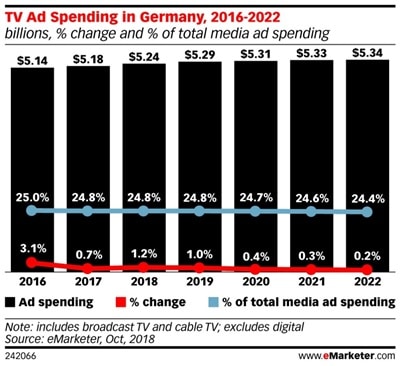
The research, from eMarketer’s latest European ad spending forecast, indicates that TV’s share will keep dropping through 2022.
This year, total media ad spending in Germany will climb to $21.13 billion (€18.74 billion), with TV taking a 24.8% share or $5.24 billion (€4.65 billion), down slightly from its peak in 2016 of 25.0%.
TV’s share of total ad spending in Germany is shrinking largely because digital’s share is increasing. This year, digital ad spending will grow 5.5% to $6.74 billion (€5.96 billion).

That equates to nearly 32% of total ad spending in Germany, compared with 30.6% last year. All of the preceding figures have been revised higher since the Q1 forecast due to strong digital growth, driven largely by Google and Facebook. By 2020, digital ad spending is expected to surpass one-third of all ad spending in Germany.
Much of digital’s growth, not surprisingly, comes from mobile. This year, mobile will make up more than half (52.7%) of all digital ad spending in Germany, equating to $3.55 billion (€3.15 billion). Smartphone adoption is a key driver; it will reach two-thirds of the population this year, putting Germany on par with the US and UK.
“Several other factors are also driving mobile ad spending in Germany,” eMarketer principal analyst Karin von Abrams said. “For example, time spent on mobile devices is rising sharply, with the internet accounting for most of that time, as consumers keep up with news, monitor travel updates, shop, and check in to social networks. In addition, we’ve seen several key industries in Germany—notably retail and automotive—raise their investment in mobile ads in 2017, and we expect that to continue.”
Methodology
eMarketer’s forecasts and estimates are based on an analysis of quantitative and qualitative data from research firms, government agencies, media firms and public companies, plus interviews with top executives at publishers, ad buyers and agencies. Data is weighted based on methodology and soundness. Each eMarketer forecast fits within the larger matrix of all its forecasts, with the same assumptions and general framework used to project figures in a wide variety of areas. Regular re-evaluation of available data means the forecasts reflect the latest business developments, technology trends and economic changes.
